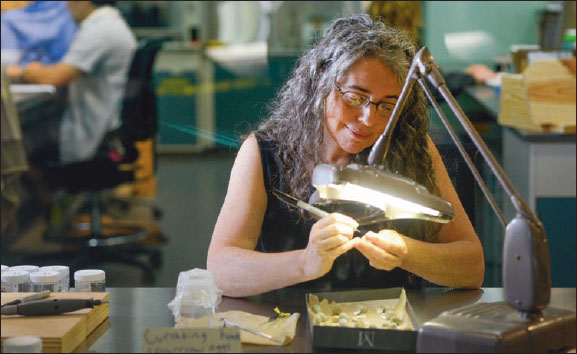
This song is Copyrighted in U.S., under Seal of Copyright #154085, for a period of 28 years, and anybody caught singin’ it without our permission, will be mighty good friends of ours, cause we don’t give a darn. Publish it. Write it. Sing it. Swing to it. Yodel it. We wrote it, that’s all we wanted to do.
—WOODY GUTHRIE (message on mimeographed copies
of lyrics distributed to fans in the 1930s)
AFTER GRADUATING FROM GEORGIA TECH, WENDY BROWN RETIRED HER pom-poms from the Atlanta Falcons cheerleaders and moved to California to start her PhD studies in biomedical engineering at the University of Caliornia–Davis. In her spare time she stayed on the sidelines, first cheering for the Sacramento Kings in the NBA, and then synching her Rockette-style kicks with the Oakland Raiderettes. Brown is one of the Science Cheerleaders, a squad of three hundred current and former cheerleaders pursuing careers in science, technology, engineering, and math (STEM). Former Philadelphia 76ers cheerleader Darlene Cavalier founded the Science Cheerleaders in hopes that cartwheels will flip public stereotypes of scientists and cheer girls into STEM careers.
During the 2014 basketball season, Cavalier, Brown, and other Science Cheerleaders teamed up with the 76ers to create a citizen science halftime show. While rousing the fans with cheers and acrobatics, they spurred the crowds into action. Together with the 76ers Flight Squad (halftime entertainers), they blasted microbe collection kits (wrapped in T-shirts) out to fans with a powerful shirt cannon. They repeated their performance at major NFL, NBA, and MLB events. That spring, sports fans collected about four thousand samples of microbes living on their shoes and cell phones.
An invisible world of microbial organisms lives on us, in us, and around us. On every surface is a rich ecosystem. In the acclaimed Dr. Seuss book Horton Hears a Who, an elephant named Horton detects a tiny civilization living on a dandelion. Like the dandelion, our bodies—and every other surface, both animate and inanimate—host tiny communities of beings. Your skin may crawl when you think about miniature life that calls you home, because these microbes are actually crawling (and slithering, spiraling, and sliding) on your skin.
The microbial samples collected from sports fans went on journeys to laboratories near and far. Some of the samples were sent to the Argonne National Lab’s Jack Gilbert, who is painstakingly constructing an earth microbiome map. No one yet knows where to find hot spots of microbial biodiversity. There are more plants and animals in the tropical equatorial areas of earth. Are there similar geographic patterns to microbial diversity? Or, could we be creating microbial Amazon rainforests in stadiums, schoolyards, malls, and other places bustling with well-traveled people?
Some of the samples from sports fans, as well as swabs of national landmarks like the Liberty Bell, went on a longer journey. For the first leg of their trip they were cultured in the lab of Jonathan Eisen, a professor at UC–Davis. Eisen’s lab set the microbes in a gel of nutrients in preparation for the second leg of their journey: their launch in a payload to the International Space Station (ISS) on April 18, 2014. People who looked up at the right time saw the ISS flying by at seventeen thousand miles per hour; inside were seven astronauts taking notes on the growth speeds of microbes in what they called the playoffs of the micro–Super Bowl. The playfields were petri dishes;66 the referees were the astronauts. NASA supported the project because it might be useful to know how bacteria grow in zero gravity in preparation for eventual plans to send astronauts on longer trips to places like Mars. The playoffs revealed that only one bacteria grew better in space and only one type grew worse. By and large, gravity (or lack thereof) didn’t seem to matter for something so small. So far it seems the high levels of radiation in space don’t matter either—at least not for growth rates.
Astronauts also sampled high-touch surfaces on the ISS and sent those to the Eisen lab, where they use DNA sequencing to identify the types of microbes that have colonized the space station. The ISS is a great place to take samples and make comparisons to buildings on earth, because the radiation levels are high in space and the source populations are limited to spacecraft and the humans and food on them.
Cavalier and Eisen, both out-of-the-box thinkers, concocted this out-in-space plan. Mark Severance, the director of the Human Space Flight Network at NASA’s Goddard Space Flight Center (who also volunteers as the Science Cheerleaders’ “Space Guy”), christened the project with the mother of all acronyms, Project MERCCURI (Microbial Ecology Research Combining Citizen and University Researchers on the International Space Station). The organization that brought the Science Cheerleaders together with Gilbert and Eisen to create Project MERCCURI was SciStarter, also founded by Cavalier. SciStarter is an online site that matches, free of charge, tens of thousands of curious people with citizen science projects. The SciStarter menu boasts thousands of projects and filters to help individuals find projects that align with their interests, skills, location, and hobbies.67 (You are now halfway through this book. If you are not yet involved in a citizen science project, visit SciStarter.com and find the project of your dreams. Better yet, create a SciStarter account and easily participate in many projects of your dreams.)
In previous chapters, we met folks drawn to citizen science through games, or matched to projects by their hobbies devoted to birds, butterflies, ladybugs, weather, and stars. The origin of citizen science in microbiology is different. There was never a large preexisting pool of microbe enthusiasts who stroll down paths with microscopes around their necks or petri dishes in their pockets. There haven’t been microbe enthusiasts calling for the long-term monitoring of microbial population trends, as with birds and butterflies. For most of human existence, microbes were unknown to us. The only way to see microbes with the naked eye is when they grow in large colonies, like mold on bread. When people spot mold, they are more likely to toss it into the garbage than grab a field guide to identify which type it is.
Citizen science in microbiology began when technology got cheap enough and fast enough in sorting and identifying this previously invisible world that the scale of research could handle the high volume of samples crowds can collect. Citizen science with the invisible world features short-term projects driven by specific research questions and leading relatively quickly to answers to mysteries, such as how many types of microbes inhabit our skin. Microbiologists are casting wide nets into unexplored invisible frontiers. Eventually they will hone in on promising areas. In the meantime, microbes in space collected by sports fans with the help of cheerleaders may not qualify, believe it or not, as hands down the most bizarre activity in this arena. There may not be rivals in other disciplines, but in microbiology, stranger things can happen.
Holly Menninger, director of public science at North Carolina State University, and Rob Dunn, an applied biology professor at NC State, operated a series of short-term projects housed under the umbrella Your Wild Life. These projects were rapid experiments, each inspired by a pressing question, followed through by data collection and analysis, and then completed.
In 2011, with the launch of the Belly Button Biodiversity Project, the intrepid participants who donated samples by swabbing what looked like a giant sterile Q-tip into their navels contributed to the discovery of hundreds of new bacteria. Dunn and his colleagues found over 2,300 types of bacteria in their first sample of donations from just sixty navels. They learned that when we contemplate our navels, most of us are likely ruminating on about seventy different types of bacteria. A group of eight microbial types, referred to as oligarchs, are predictably common in the navels of many people and abundant when present. The remaining thousands of types were each quite rare, often native to a single navel. The microbes tucked into our navels are a representative sample of the microbes covering all of our skin, and we appear to be island archipelagos hosting many hidden biodiversity treasures.
Dunn’s research group hoped patterns of microbe diversity in navels could be explained by age, sex, ethnicity, “innies” versus “outies,” and the frequency of belly washing, but none of these hypotheses panned out. Other than the common oligarchs, Dunn could not predict what microbes were likely to be found in a given umbilicus.
Dunn went back to participants for more data and uncovered that where you grew up slightly influenced your navel fauna. The baguette-eating French host a composition of navel bacteria that are different from those of bagel-eating New Yorkers and again different from biscuit-eating North Carolinians. Yet there was still a lot of variation left to explain. When they felt completely stumped, Dunn turned out the data to the public with one big shrug. “Have at it,” he said.
Sharon Berwick, a mathematician at the University of Maryland, was accustomed to finding patterns in big data, and decided to take a look. She is preparing a research paper with her findings. Belly buttons sort out according to whether they are dominated by bacteria that metabolize in the presence of oxygen (aerobic) or the absence of it (anaerobic).
The belly button biodiversity research informed the next iteration of questions, such as how our skin microbes may affect our susceptibility to mosquitos. The sweat we produce does not have an odor. Rather, our body odor comes from our individual microbiome—could the odors of microscopic critters living on us attract the bigger, buzzing critters that suck our blood? In hope of answering this question, people have been donating their skin microbes to science.
This navel biodiversity research also branched into the study of armpit microbe communities and whether the suitability of armpit habitat is shaped by deodorants and antiperspirants. Led by Julie Horvath at the North Carolina Museum of Natural Sciences, the study asked volunteers who normally use hygiene products to stop for at least a couple of days and those who normally don’t use these products to use them daily. The deodorants and antiperspirants achieved their intended outcomes: when someone started using the products, the richness of their microbial armpit community declined. Similarly, when deodorant and antiperspirant use was stopped, bacteria density increased to become similar to those who normally don’t use these products. Notably, the types of bacteria living in the armpits of typical product users who abstained briefly were different from those who in the long-term go au naturel. Those who normally do not use products have armpits dominated by Corynebacterium, while the armpits of those who briefly stopped using the products were quickly overrun with Staphylococcaceae.
Unfortunately, inferences about what these patterns mean are limited because researchers are only identifying bacteria to these basic types rather than to the details of the precise species present. To put this in perspective, identifying an animal as Panthera tells me it isn’t a house cat (Felis catus), but doesn’t tell me if it is it a tiger (Panthera tigris), lion (Panthera leo), leopard (Panthera pardus), or jaguar (Panthera onca). You might be wise to treat all Panthera with the same caution, but that’s not necessarily the case with microbes. Some types in the Genus Staphylococcus are beneficial, while others (Staphylococcus aureus, for example) are sturdy pathogens that rampage through hospitals. Similarly, most Corynebacterium are harmless, but one type causes diphtheria.
As is common in science, the findings of one study raise more questions than they answer. Dunn’s philosophy, he explains, is that “the next question should be motivated by our findings, not by a desire for new data. Until a new question is asked, there’s not much value in new data.” That’s a practical philosophy because, with microbes and their DNA, it is easy to quickly experience a data deluge.
The longest running project within Your Wild Life was Wild Life of Our Homes, which was designed to identify which factors determine whether a home is a teeming metropolis of diverse, invisible life or a desolate boondock. Menninger estimates that after two years of sampling, they probably have enough data for ten years of analysis to make sense of it all.
To participate, people signed up via the Internet and received microbial swab kits in the mail. Each kit included a protocol and sterile swabs to collect samples from designated areas around their home. In homes, the designated areas were initially inner and outer doorframes, kitchen counters, and pillowcases. From the pilot study, Dunn and Menninger found that different surfaces in homes equate to different habitats. A food habitat includes kitchen and eating spaces. A human body habitat is associated with where people spend time, like beds and bathrooms. An outdoor habitat, such as window sills and doorframes, is related to locations where life enters from the outside. After the pilot study, more designated areas were added, including toilet seats and TV screens.
What governs the distribution of microbial life? To collectively find out, when each participant sealed swabs and mailed them to North Carolina State University, they also filled out an online questionnaire to provide details about their home and its occupants. When the swabs arrived in Raleigh, Menninger placed them in a freezer to keep the bacteria from growing. Once they had a critical mass to make the processing cost-effective, they started to tally the diversity of microbes in the samples based on DNA sequences.
The logistics of genetic processing of microbial samples are challenging, because microbes are everywhere, including on researchers and the lab bench. Microbiologists take great care so that local microbes don’t contaminate samples of microbes taken from afar. For the Wild Life of Our Homes project, the lab of Noah Frierer, a collaborator at the University of Colorado–Boulder, was entrusted with the process. Frierer, in turn, used a combination of technicians and a robot to meticulously turn samples collected by citizen scientists into data on the genetic code of microbes.
Dunn and Menninger found no two countertops contained the exact same microbial diversity. Ditto for pillow cases, doorframes, and toilet seats. Though not identical, species composition was more similar within each habitat (a pillowcase in one household compared to a pillowcase in another household) than within each house (a pillowcase compared to a kitchen counter).
Dunn’s group examined many factors that failed to predict which homes would be populated like microbial cities and which would be like a microbial ghost town: not the number of people living in the house, nor the presence of children, pesticides, or carpet.
Man’s best friend was the answer. Dunn’s group compared the microbiome of homes with pet dogs to the microbiome of homes without shaggy inhabitants. The presence or absence of a dog in the house explained almost half the variation in the types of bacteria on pillows and TV screens (microbes get stuck with static cling). Also, the composition of fungi in homes was influenced by regional fungal communities outside. Where you live mattered for fungi, but not for bacteria. Who you live with matters for bacteria. For one variable, dogs, to explain half of the variation in an ecological pattern is as much a contribution as one of your parents made to explain your own personal traits. Dunn speculates that dogs reconnect us to the diversity of species that occur in the great outdoors but which don’t usually make it into our homes. They may even help our immune system.
The Wild Life of Our Homes project may one day revolutionize microbiome research, but so far it has been taking incremental steps through microterrain. Menninger explains, “There’s still a lot of growing pains and newness in the field. Things are really evolving and moving quickly. The field is still moving through the descriptive phase of the research, such as who’s there and why. I think the big stuff will come next when we think about applications to health and forensics.”
With regard to forensics, the Wild Life of Our Homes project could operate like a Sherlock Holmes clue. Microbe communities are unique enough to function like old-fashioned fingerprints. The Homes (Holmes!) project was able to predict the geographic location of a sample based on its fungal community to within two hundred kilometers. Further sampling with indoor microbes could reduce the size of the fingerprint, making it useful for solving crimes. A murderer may wipe his fingerprints from the weapon or victim, but he can’t remove his signature composition of microbes. Remember, we each have a distinctive body odor and breath, and these are autographs of unique microbial communities.
With regard to health, Menninger is referring to the hygiene hypothesis, an idea that cleanliness may not actually reside next to godliness. Better hygiene has contributed to decreases in the rates of infectious disease, but an excess of these hygienic practices may be contributing to soaring incidences of allergies and autoimmune disorders (e.g., type 1 diabetes). In the last decade, asthma has reached epidemic levels in industrialized countries. Similarly, atopic dermatitis, also called eczema, has increased in the last three decades, affecting 15 to 30 percent of children. For decades, an industry waging war on microbes has grown, selling antibacterial soap, disinfectants, and hand sanitizers. Now the low microbe diversity in our overly sterile, antibacterial crazed lifestyles may be backfiring on immune systems. Although plenty of types of microbes are harmful, microbiologists have identified plenty more that are helpful or neutral to our health. For the majority of invisible life, they don’t know which are good and which are bad. It’s uncertain whether we benefit from exposures early in life that challenge our immune system, or whether exposure causes lasting harm.
Microbiologists involved in citizen science anticipated facing a challenge in convincing people that most microbes were not villains and were worthy of their attention. To the contrary, people have taken the hygiene hypothesis to heart, and then some. Participants commonly have a desire to find miracle microbes on their bodies. Unexpectedly, researchers have to conscientiously dispel misconceptions about the sensational powers of microbes. They have to repeatedly ask participants to not interpret the personal results of their microbiome composition as medical advice.
Eisen operates a website dedicated to dispelling myths about new industry-driven claims and misinformation about microbes as medicine. The field is teetering on the edge of a solid understanding of the microbiome. Answers to many microbe mysteries are tantalizingly close, “but not close enough,” warns Menninger. To date there is only one valid microbe-based medical treatment, which is fecal transplant to treat those infected by Clostridium difficile, a microbe found in the gut. As it sounds, the procedure involves transplanting feces from a healthy donor to the colon of an unhealthy patient. It works because the healthy gut microbes prevent C. diff. from taking over the intestines of the patient. When valid treatments involve poop donations, how can the average person differentiate a far-fetched claim from a substantiated claim? “Misinformation from businesses wanting to make a buck play on the incredibly personal meaning of each citizen science sample. That is dangerous,” Menninger cautions. “Participants tend to see their results as diagnostic, and they are not. They are only explanatory in the collective.” Although it is an appealing notion, one can’t simply analyze the microbes on his or her pillowcase or toilet seat and draw conclusions about personal health.
By and large, current studies of the microbiome mimic the 1800s-style natural history of explorers Meriwether Lewis and William Clark: observing, classifying, and piecing together observations into bigger patterns. Researchers and citizen scientists journey out, collecting and identifying specimens from as many unexplored places as possible to map the diversity of (miniature) life in the world. With microbes, every place is unexplored terrain, from the New York City subway (currently being mapped with PathoMap by Weill Cornell Medicine) to air and soil (by Noah Frierer’s lab at the University of Colorado) to individual armpits (with Your Wild Life at North Carolina State University and the North Carolina Museum of Natural Sciences) to the International Space Station (by UC-Davis). Now that we have the techniques to uncover invisible worlds, citizen science and traditional science are in the same boat, overwhelmed by the microbes that exist everywhere. The field is focused on basic biogeography, the study of places and what lives in those places. The next phase will be to find out why microbes live where they do and to study the consequences of their distribution—particularly as regards human health.
In microbiology a unifying concept has been germ theory, the notion that diseases are caused by microbial organisms. The idea that entities too tiny to see were causing diseases was first proposed in 1546 by Italian scholar Girolamo Fracastoro in what he described as spores that could transmit disease. He was an atomist—that is, he believed that chemicals were made of smaller components that we could not see, called atoms. So it wasn’t a big leap for him to say the same for disease agents. Before germ theory, people assumed that diseases spread by miasma, the term for noxious air from decaying matter. While breathing in a gust of odor from roadkill may induce a sudden visceral sickness, miasma was incorrectly fingered as the culprit that brought epidemics of cholera and the Black Death.
Unlike germs, germ theory spread slowly. For example, in the mid-1800s Austrian obstetrician Ignaz Semmelweis noticed that new mothers were dying of fever after giving birth with the help of doctors and medical students, but not after births assisted by midwives. When he convinced doctors to wash their hands with chlorinated lime water before entering the birthing room, which was on the rotation following the autopsy room, death from childbirth went down from 18 percent to 2 percent at Vienna General Hospital. Still, the medical establishments rejected Semmelweis and his ideas about germs. Mules, mountains, and scientific establishments rank in the top three on the list of things that are nearly impossible to move. Remember this—centuries of stubbornness—as we soon begin to consider how citizen science might reorganize the scientific establishment today.
But first, let’s look at how microbes were finally seen.
It was in the 1670s—one hundred years after Fracastoro, and almost two hundred years before Semmelweis—that microorganisms were first seen by the human eye. Although Fracastoro had speculated the existence of disease-carrying spores too small to be seen, when microorganisms were finally seen, the discoverer studied them with fascination and awe, never associating them with germs.
The honor of the achievement of seeing microorganisms for the first time goes to Antonie van Leeuwenhoek (credited as the father of microbiology) in 1676. I want to highlight Van Leeuwenhoek’s career because he straddled the blurry line between what we’d consider an amateur scientist today and a man of science of his day. He was not part of the scientific establishment; only after landing a job as a civil servant at age forty did Van Leeuwenhoek come into contact with intellectual elites like Robert Hooke,68 who was part of the nucleus that formed the Royal Society of London. While men of science conversed in Latin, Van Leeuwenhoek only spoke, read, and wrote in modern Dutch. Nevertheless, he published over five hundred papers, keeping at it until he was more than ninety years old and on his deathbed. He was an anomaly among natural philosophers because he never taught students or visited a university.
Van Leeuwenhoek differed from important scientists of his day in another pivotal way. Hooke, for example, was interested in using microscopes to understand more about already familiar organisms like lice, silkworm eggs, and the wings of flies. Leeuwenhoek, like citizen microbiologists today, sought out otherwise invisible life. Instead of searching navels and doorframes like Your Wild Life, he searched milk, blood, and water in ponds, lakes, and streams for miniature life never before encountered.69 His blue-collar background gave him an advantage that he carried close to his chest: he had developed a method with which to make powerful lenses. In his younger years as a cloth merchant, he used lenses to judge the density and weave of fabric, and he must have learned a thing or two from his hands-on practice.
Van Leeuwenhoek’s secret technique involved putting a flame to the middle of a small rod of soda lime glass until it pulled apart like taffy into two long whiskers of glass. Then he would apply the flame to one of the whiskers until it formed a very high-quality glass sphere. The smaller the sphere, the greater its ability to magnify. With sophistication he would grind and polish the spheres to perfection, some becoming as thin as one millimeter and with a radius of curvature of 0.75 millimeters. He would mount a lens in a hole in a brass plate, in line of sight of a sharp point to hold the specimen. The focus was adjustable with a couple of screws. His contraptions were three to four inches long, with lenses that magnified as much as two hundred times. The top-of-the-line compound microscope of the day, which used two lenses, was invented in the 1590s and was available to Hooke but only magnified twenty or thirty times.
Being secretive was common then and, some might argue, now. For example, at the time, not only were scientific communications expected to be in Latin but it was also customary for men of science like Hooke to stake claim of their emerging discoveries through anagrams, short unreadable messages with the words or letters out of order. They announced their breakthroughs as if in a jumble puzzle in the Sunday paper in order to prevent anybody else from claiming they made the discovery first. They would print an anagram for anyone to read, and later the author would expose its meaning. For example, in 1655, Christiaan Huygens reported his discovery of a moon around Saturn (now called Titan) by telescope with an anagram about the moon’s orbital period: “ADMOUERE OCULIS DISTANTIA SIDERA NOSTRIS UUUUUUU CCCRRHNBQX.” In 1656 he unscrambled his anagram, leading to the Latin sentence Saturno luna sua circunducitur diebus sexdecim horis quatuor, which translates to “A moon revolves around Saturn in sixteen days and four hours.” He had another for rings of Saturn, which he revealed only after three years because that is how long it took him to secretly validate his finding: “encircled by a ring, thin and flat, nowhere touching, inclined to the ecliptic.” Aptly, Christiaan Huygens’s own name was an anagram: “Anarchy, this genius.”
Galileo sometimes used anagrams too, but he didn’t in his 1631 book Dialogue Concerning the Two Chief World Systems. A year later he was under house arrest and required to renounce the Copernican view of the solar system in which the planets orbit the sun instead of orbiting earth. It is no small wonder that scientists mostly shared discoveries only with each other at conferences and then policed themselves in journals, creating traditions that separated scientists from outside scrutiny, but also from laypeople.
Van Leeuwenhoek’s powerful, secret lenses, coupled with his outsider status, put him in the same predicament as Horton the elephant in Dr. Seuss’s book. In the 1670s, Van Leeuwenhoek began reporting on the existence of single-celled organisms, which he called animalcules. With the help of a translator, in one paper he submitted to the Royal Society (this was almost a century before William Whewell received his Royal Medal, as I noted in the introduction) he reported animalcules on pepper grains he had soaked in water for three weeks. Members of the Royal Society were skeptical; after some kerfuffle, they decided to settle the matter by sending a team of respected observers to visit and confirm Van Leeuwenhoek’s observations. The situation is not unlike what citizen scientists face today when they need to provide photographic documentation of their observations (for a discussion of this, see chapter 8). The members of the society needed only a glimpse of Van Leeuwenhoek’s secret lenses, and his discovery of animalcules and many other tiny discoveries, to recognize his competency. After a decade of discovery he was finally chosen to be a jolly good fellow of the Royal Society in 1680.70 Later, in the 1680s, he explored where even Your Wild Life doesn’t venture and found animalcules in the white matter stuck to his teeth. Though Van Leeuwenhoek is considered the father of microbiology,71 the field did not bear any immediate children. It was many years, perhaps a century, later that microbes would again be the subject of intense research interest, this time as sinister sources of disease.
The twenty-first century’s academic children of microbiology are rebelling against their father Van Leeuwenhoek by abandoning secrecy and adopting open science practices. They have no choice, given the data deluge and citizen science participants who are impatient for answers about what invisible life inhabits their belly buttons, armpits, and windowsills.
According to “The Tao of Open Science for Ecology,” a paper coauthored by Stephanie Hampton of the Center for Environmental Research, Education, and Outreach in Pullman, Washington and her colleagues, open science is the “concept of transparency at all stages of the research process, coupled with free and open access to data, code, and papers.” Researchers who adopt open science practices view themselves as stewards, rather than owners, of data. Dunn displayed open science when he shared the entire data set on navel microbes. Open science practices go hand in hand with citizen science because participants expect to be kept in the loop—and rightly so.
For some scientists like Dan MacLean, adopting open science practices with colleagues was a gateway to citizen science and being open with the public. MacLean, the head of bioinformatics at the Sainsbury Laboratory and the John Innes Center, was drawn to open science because it is the quickest way to battle a fungus that causes disease in trees in the United Kingdom. The disease agent is Charlar fraxinea (the name of the anamorph stage),72 or Frax, which is causing a rapid loss of ash trees (called ash dieback) from treasured English woodlands.
MacLean began an open research program to sequence the genome of Frax in hopes that the genetic code would reveal solutions to cure or prevent ash dieback. With a quick solution as the primary concern, he decided that the research strategy needed to be ultracollaborative. Usually scientists will generate data, analyze that data, and collaborate with a few trusted coworkers; when they have made sufficient use of the data in a series of publications, then they might share the data with other scientists. MacLean describes the traditional system bottleneck, in which work is vetted by a small number of people and then available to a restricted readership via journal subscriptions, as “filter, then publish.”
MacLean describes open science as “inverting” the old system; he prefers “publish, then filter” because that allows faster progress with a larger community of minds. Through the open science paradigm there is no need to wait to share data and insights; it is better to share an incomplete story with a community of researchers who are ready and waiting for the release of data. Immediate review and criticism is music to a scientist’s ears because it translates into rapid advances.
To figure out what makes the fungus so deadly to ash trees, MacLean’s lab collected DNA from infected trees, sequenced it, and released the data to crowdsource the analysis. Through a project called Open Ash Dieback, MacLean continually releases genomic data on the fungus to a public website hub as soon as his lab sequences it, before he and his colleagues even begin any analyses. He says this research approach is “in the vanguard of a new movement.”
Rapid DNA sequencing and similar genetic methods produce too much information for scientists to handle, and even too much for scientists from multiple disciplines tackling the problem together. The doors of open science need to be propped ajar so the public can stroll in. Thus, MacLean’s next step was to use citizen science to engage more minds in data analysis. MacLean’s group developed a Facebook game called Fraxinus, similar to Phylo (see chapter 6), through which players can, without any training, figure out solutions to multiple sequence alignment problems. A distributed crowd of friends is like a human supercomputer. In the first year, players spent over nine hundred days on Fraxinus. For the trickiest areas of the Frax genome, people proved better at finding alignments than did computer algorithms.
Open science works. The first open dieback data led to the certain identification of the pathogen Hymenoscyphus pseudoalbidus. Within two months, researchers had built two libraries of genomic DNA of H. pseudoalbidus, annotated for searchers by chemists who specialize in fungicidal compounds. Chemists soon created a candidate target for fungicides. Specialists in fungal secondary metabolic pathways used the genomics data to identify fungicidal compounds that were potentially toxic to Frax. Other analyses suggested the disease is entering the tree by decaying its wood. Another finding quickly identified two mating types in one small area, which meant that the pathogen was from multiple origins. These types were then found in tree nurseries and recent plantings, suggesting that the sale of seed and saplings was one cause of the spread of the disease. Open science—open sesame! Like magic, tactics to slow the spread of the malady were quickly in sight.
Open science does just what the phrase implies: opens the discovery process by adopting a style that breaks traditions. Public science, open science, and citizen science are already creating new traditions of sharing, and these are all departures from the old ways. The fundamental steps of the scientific method haven’t changed much, but a short trip through history can illustrate the slow but steady progress in opening the curtains that keep new knowledge hidden from public view. Let’s take a look at past restrictions on the spread of knowledge in order to prepare for a future of the highly accessible, open, and public generation of new knowledge.
It is disappointing to have a paper full of one’s scientific revelations rejected from a journal, and negative reviews from one’s peers can cut to the quick. Yet it beats house arrest, prison, or being burned at the stake. During the Renaissance, the closest validation system to modern-day peer review was limits placed by state and church censorship. A tragic example is Michael Servetus, who, in 1553, was the first person to correctly describe human pulmonary circulation. Unfortunately, he reported the details of heart ventricles (blood passed from the right to the left through the lungs) in Christianismi Restitutio (The restoration of Christianity), a book in which he also expressed his religious views, which were considered heretical at the time. He rejected the idea of a trinity in favor of a unified God, and also the principles of infant baptism. He wasn’t throwing the baby out with the bathwater, but simply rejecting the concept of predestination, insisting that individuals start out good and only through their words or deeds can become unworthy and thereby condemned by God. John Calvin and the Geneva Council convicted Servetus of heresy, for which he was burned at the stake with what was believed to be the last copy of his book chained to his leg.
Originally, most of the copies of his book were unbound and tied in bails to look like paper. The ruse didn’t work, and almost all of the copies were destroyed as soon as they appeared for sale. Fortunately, three copies of his book somehow escaped destruction and appeared decades later when they were more easily distributed. Servetus’s studies of human physiology propelled medicine, and his religious views became a key part of the Unitarian Church.
The Royal Society founded a journal called Philosophical Transactions in 1662 and submissions were reviewed by the editor (and, in the exceptional case of Van Leeuwenhoek, a group of trusted visitors). Editors assessed whether contributions followed standard practices of creating scientific knowledge, such as eliminating possible explanations based on observations until the last remaining explanation could be accepted as the most likely—a principle first articulated in 1620 by Francis Bacon in his Novum Organum Scientiarum (New instrument of science). Continual improvements to typewriters throughout the 1800s, which led to carbon copiers in 1890 and eventually Xerox copiers in 1959, also led to slow changes in journal practices. The ability to easily make multiple copies of an article for review meant that every manuscript submitted to a journal could be scrutinized by several other scientists for independent opinions on the research. So-called peer review became common practice for all academic journals in the 1960s. Many great innovations, including theories propagated by Charles Darwin and Albert Einstein, were not peer reviewed in the manner that is the norm today.
Eurocentric science has grown into a monolithic and colossal field. As gates went up around the system of creating knowledge, it also went up around the knowledge itself. Print journals required subscriptions; when journals went to online formats, most retained a subscription fee. With the Internet otherwise full of free information, having the products of taxpayer-funded research located behind a paywall has raised some fundamental questions about intellectual property and freedoms. The argument isn’t only about what’s fair. Closed science creates roadblocks that make it slower than open science. And new knowledge is not spontaneously generated, but built on the foundation of what’s already known, on the shoulders of giants—unless the giants, or the legacy of their works, are hidden behind paywalls.
Aaron Swartz (who gave us an alternative analysis of Wikipedia users in chapter 2) was a founder and developer of Reddit in his teen years; he grew into an adult advocate for open knowledge.73 In January 2013, at the age of twenty six, he committed suicide, unable to cope with harsh prosecution by the criminal justice system for committing a victimless crime: Swartz had downloaded and made public millions of academic articles from an archive called JSTOR. Although Swartz had library access to all the articles in JSTOR, sharing these articles with others violated the archive’s terms of service agreement. During a two-year ordeal, Swartz was prosecuted under the Computer Frauds and Abuse Act, among other regulations. He was fighting thirteen felony counts and facing up to thirty-five years in prison and a $1 million fine. Swartz was an idealist committed to Internet freedom; his actions were political, not for profit. At the time, no one imagined he would get charged with a federal crime, much less that he’d face prosecution with no option for a plea bargain. In fact, he was so confident that he would not meet serious consequences for his actions that he did not try to hide his activism: he placed the computer that was accessing JSTOR in a place that obviously had surveillance cameras. Everyone wised up to the seriousness later. When I speak on the phone with John Wilbanks, a proponent of open science, he reflects, “the copyright lobby was never going to let anyone get away with what Aaron did.”
Swartz’s act of civil disobedience, and the case against him, added momentum to an open-access campaign called Access2Research. About a year before Swartz’s suicide, the quartet of Wilbanks, Heather Joseph (executive director of the Scholarly Publishing and Academic Resource Coalition), Michael Carroll (a law professor at American University), and Mike Rossner (then director of Rockefeller University Press), launched Access2Research to convince the White House to mandate that journal articles arising from taxpayer-funded research be freely accessible on the Internet. Their strategy involved flexing their right to petition the US government, which is granted by the First Amendment of the Constitution (in the same clause as the right to assembly, free press, free speech, and freedom of religion). In 2011 the White House developed a procedure for petitions and criteria for government response: the petitions platform is called We the People. In those early days, using the site to demonstrate sufficient public support for a cause, and getting the president’s attention, meant getting twenty-five thousand signatures in a month (now that the site has caught on, the threshold for the president’s attention is 100,000 signatures).

Author Caren Cooper, visible to the public in her lab behind a glass wall at the North Carolina Museum of Natural Sciences, is curating eggs of invasive House Sparrows. The eggs were collected and sent to her by volunteer birdwatchers as part of a citizen science project with dual purpose: to evaluate methods for minimizing damage to protected birds by House Sparrows; and to assess the potential for House Sparrow eggs to function as a biomonitoring tool allowing communities to quickly index levels of environmental contaminants.
(Photo courtesy of NC State University)
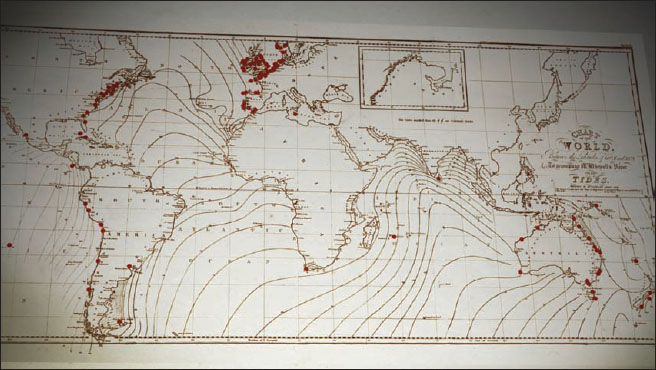
In a pioneering example of citizen science, William Whewell orchestrated the Great Tide Experiment, a data collection event that largely contributed to his award-winning research on ocean tides. In the Great Tide Experiment, thousands of ordinary people simultaneously monitored the tides with tide gauges at hundreds of sites across the world, providing Whewell with millions of observations with which he could craft and test his theories.
(Photo courtesy of Michael Reidy/The Crowd & The Cloud)
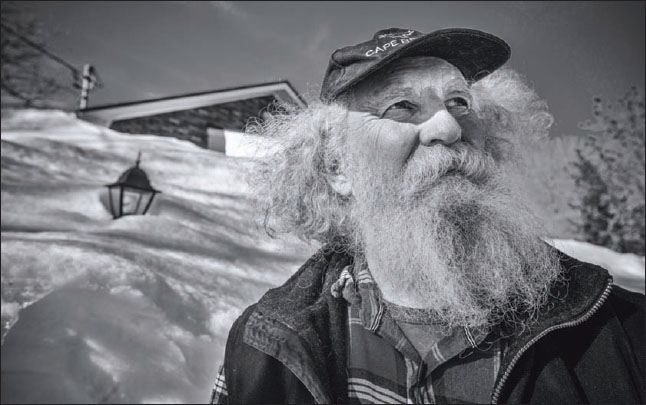
Retiree Dan Matthews, a dedicated volunteer in Moncton, New Brunswick, Canada, contributes rain and snow measurements to CoCoRaHS, the Community Collaborative Rain, Hail, and Snow Network, every day, even in the coldest depths of a Canadian winter. CoCoRaHS (discussed in chapter 1) is a volunteer network for precipitation data collection, which allows for more precise meteorological forecasting.
(Photo credit: Art Howard/The Crowd & The Cloud)
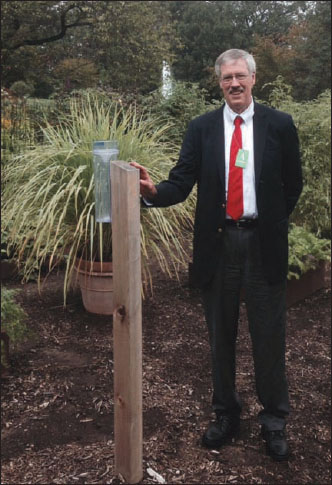
CoCoRaHS founder Nolan Doesken proudly shows off the project’s rain gauge installed in the White House garden, symbolizing the Administration’s support.
(Photo courtesy of CoCoRaHS)
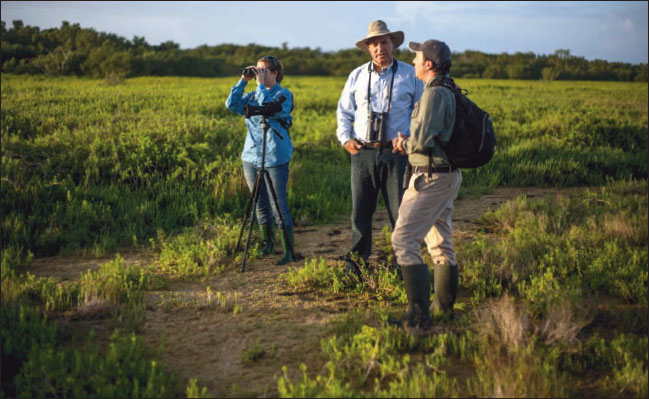
Angel and Mariel Abreu are knowledgeable and enthusiastic birders, running a guiding company with the appropriate name Nature is Awesome. They accompanied The Crowd & The Cloud host/presenter Waleed Abdalati (center) during filming in the Florida Everglades. Birders participate in citizen science projects such as NestWatch, a nest-monitoring program in North America that was founded in response to the catastrophic decline in bird species due to the widespread use of the pesticide DDT. NestWatch and other ornithological citizen science projects are discussed in chapter 2.
(Photo credit: Geoff Haines-Stiles/The Crowd & The Cloud)
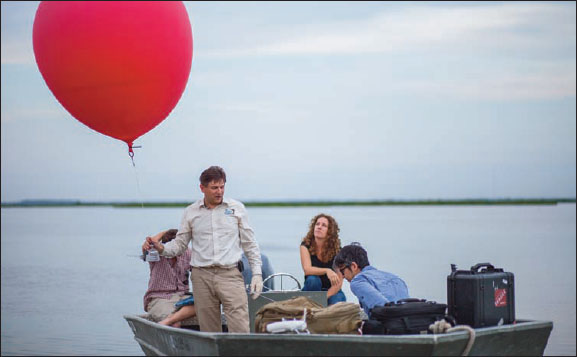
Scott Eustis (left), Shannon Dosemagen, and Jeff Warren documented the BP oil spill in the Gulf of Mexico as part of the Public Lab response to the Deepwater Horizon disaster, using open source software to stitch together imagery collected with low-cost cameras flown below kites and balloons. Since the BP oil spill, Public Lab (discussed in chapter 2) has expanded across the United States and internationally, capturing high-resolution imagery of environmental pollution.
(Photo credit: Nathan Dappen/The Crowd & The Cloud)
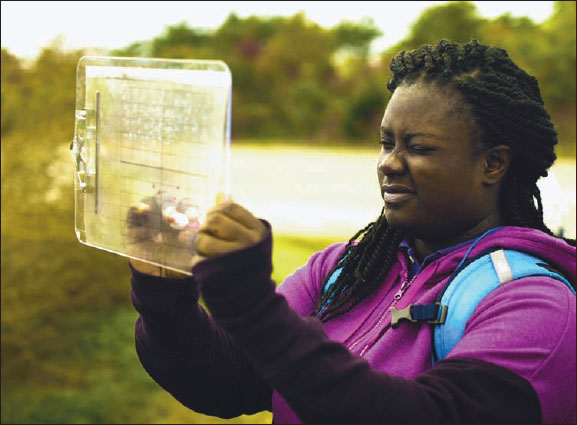
Using the Nature’s Notebook app from the National Phenology Network, teens from Rockaway, Queens, New York, participate in habitat restoration efforts in the nearby Gateway National Wildlife Refuge after Superstorm Sandy, demonstrating how STEM learning can be applied in the real world. Here they are carefully plotting where pollinators can be found on storm-resistant plants; pollinator habitats and conservation is further discussed in chapter 3.
(Photo credit: Sean Feuer/The Crowd & The Cloud)
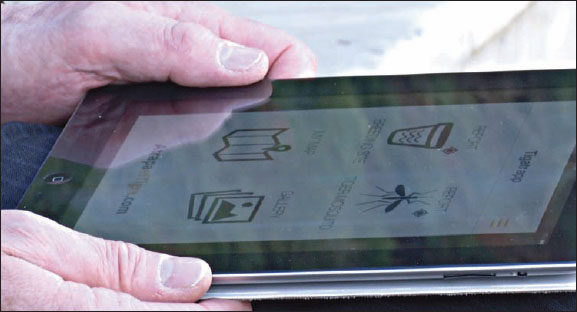
In Europe, Tiger mosquitoes spread diseases like West Nile, malaria, and dengue fever, as detailed in chapter 3. In the city of Barcelona, the “Mosquito Alert” app encourages citizens to report where mosquitoes may be breeding by submitting photos with GPS coordinates. Initially developed to attack the Tiger mosquito, the app is being updated to help combat Zika and other mosquito-borne diseases. Lessons learned from its development in Spain are being applied to a new NSF-funded “GLOBE Observer” MOSQUITO WATCH citizen science app for the United States.
(Photo credit: Geoff Haines-Stiles/The Crowd & The Cloud)
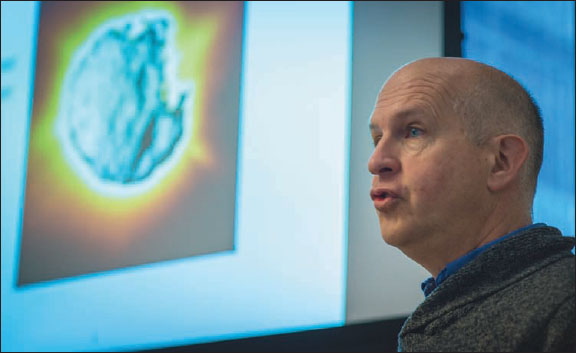
Andy Westphal is adapting the “Stardust@home” user interface—the online citizen science project discussed in chapter 4 that allowed volunteers to identify interstellar dust tracks for NASA—to support “EyesOnALZ,” a project that’s working to speed up the search for a cure for Alzheimer’s.
(Photo credit: Sean Feuer/The Crowd & The Cloud)
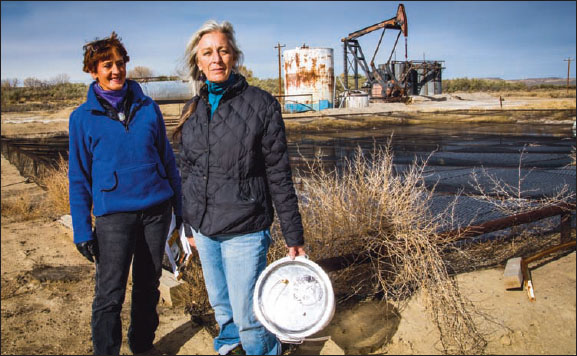
Clark, Wyoming, resident Deb Thomas (right) and one of her neighbors became part of a citizen science project using “Bucket Brigade” techniques to sample the air close to local fracking sites, which the neighbors suspected were emitting unhealthy and dangerous chemicals. Her data was included in a “Warning Signs” study from community activists, and in a peer-reviewed article in the respected journal Environmental Health Letters. “Bucket Brigade” trains citizen scientists to use relatively simple sensors and a rigorous protocol to collect air quality samples close to industrial sites, which are then analyzed by professional laboratories. As mentioned in chapter 7, water quality deteriorates in the vicinity of fracking.
(Photo credit: Nathan Dappen/The Crowd & The Cloud)
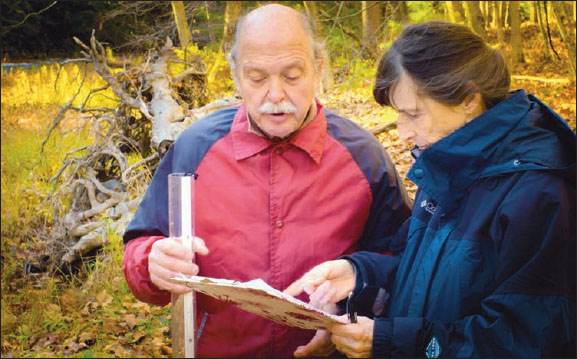
Trout Unlimited volunteers in North Central Pennsylvania monitor local streams and sample water quality and other stream measurements using an EPA-developed checklist to collect baseline data and alert local governments to spills. As mentioned in chapter 7, over 100,000 people in the United States monitor local water quality.
(Photo credit: Andy Quinn/The Crowd & The Cloud)
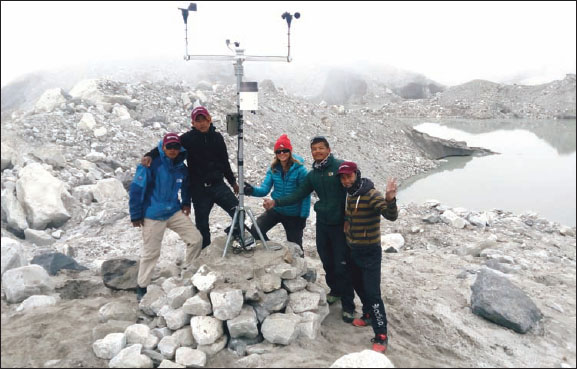
Glaciologist Ulyana Horodyskyj stands with members of the Sherpa-Scientist Initiative (SSI) in the Nepalese foothills of the Himalayas after rebuilding a weather station damaged during the 2015 earthquake. SSI trains the Sherpa to monitor the weather station instruments year-round, contributing to science and helping to understand flooding in their local environment. The SSI functions in a manner similar to that of the Silalirijiit Project, described in chapter 7, which compares climate data from weather stations with local Inuit observations in Clyde River, Nunavut, Canada.
(Photo credit: Benjamin Pothier/The Crowd & The Cloud)
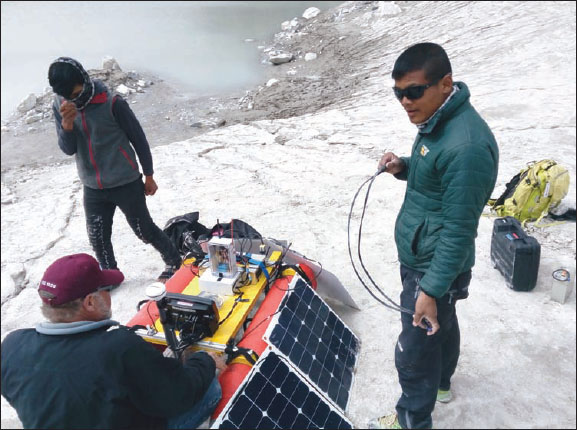
Sonam Sherpa works with science technologist Patrick Rowe to learn research techniques involving robotics and innovative sensors as part of glaciologist Ulyana Horodyskyj’s Sherpa-Scientist Initiative (SSI).
(Photo credit: Benjamin Pothier/The Crowd & The Cloud)
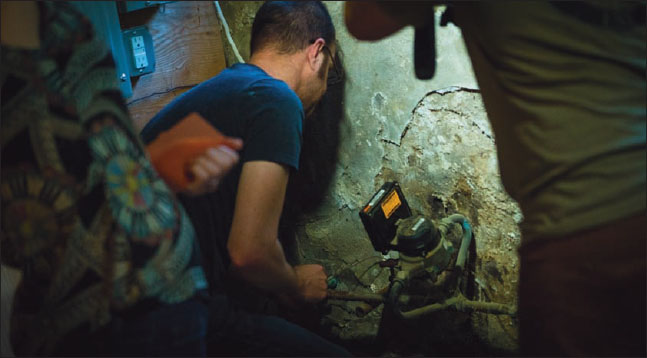
Philly Unleaded is a citizen-led effort aimed at testing the lead levels in the drinking water of Philadelphia residents. After the drinking water crisis in Flint, Michigan, (discussed in chapter 9) Philadelphia resident Jonathan King was concerned about lead levels in his city’s water. He reached out to Marc Edwards, the Virginia Tech civil engineer who had assisted citizens in Flint by testing their polluted water. Jonathan found other concerned neighbors via a Facebook group, and the Philly Unleaded citizen science project began.
(Photo credit: Sean Feuer/The Crowd & The Cloud)

Just as North Carolina citizen scientists fought back against air pollution in chapter 9, Cassandra Martin from Oakland, California, combated air pollution in her community. She joined with neighbors to count trucks emitting pollutants as part of the West Oakland Environmental Indicators Project, collecting data with a low-cost air pollution sensor, as depicted above. After presenting the community’s citizen science data to the City and Port of Oakland, the routes of trucks emitting pollutants were changed to lessen impacts on homes, schools, and day care centers.
(Photo credit: Andy Quinn/The Crowd & The Cloud)
In late May 2012, when Wilbanks, Joseph, Carroll, and Rossner created a White House petition with We the People, the movement went viral on social media. In the petition’s first day they acquired an unprecedented eight thousand signatures. They reached their goal in two weeks and acquired over sixty-five thousand signatures before the campaign closed at the end of one month. Internal White House negotiations progressed, although they paused during election season, resuming at the beginning of 2013, which coincided with Swartz’s suicide. Forty days after Swartz’s death the White House and its Office of Science and Technology Policy announced the new executive order: all US federal agencies that have significant budgets for research and development must develop open access policies within twelve months.
Joseph called the directive “a watershed moment.” In a news article, she said, “The directive will accelerate scientific discovery, improve education, and empower entrepreneurs to translate research into commercial ventures and jobs. It’s good for our nation, our economy, and our future.”
In the wake of Swartz’s suicide, the scientific profession is slowly reshuffling economics and meritocracy systems in such a way as to promote open access to the products of science. With so much politicking, prosecution, and sacrifice going into the fight to make the knowledge products of scientific research freely available, it is time to remind ourselves that citizen science goes one step further: people gain access to the process of making of new knowledge.
So far we’ve mostly encountered examples of citizen science where participants collect observations or solve puzzles as prescribed by scientists. These are referred to as contributory projects. Echoing former president John F. Kennedy, participants don’t ask what science can do for them, but what they can do for science. By following the scientists’ lead, contributory citizen science tends to reinforce the existing authority of scientists, but with important changes in the status quo operations of the scientific establishment, adding transparency and openness. In the following chapters we’ll see citizen scientists doing even more: setting research agendas, devising questions, and making decisions based on their interpretation of the results. In this way citizen scientists tend to shake up the existing structure of the scientific establishment by demanding to be shareholders in the science market. We’ll see that the same way citizen science gives people access to explore the mystery of our connection to tiny invisible life is the same way that it is supporting an enormous revolution through which access to science helps balance disparities of wealth, education, and power.
We start the transformation of science here, where microbiome research is disarming and open enough to engage citizen scientists. If a scientist feels all right with the absence of arrogance, embracing the silliness of studying invisible organisms in bellybuttons and cheering sports fans to gather samples, then people respond with a generous attitude, let down their guard, and enter the door that science is holding open.
Those nostalgic for the eras of discovery and exploration now navigate frontiers of unexplored terrain on microscopic levels. To deal with floods of data, scientists need to see themselves as part of a network in which many brains are better than one. Wilbanks humbly confides, “To state it badly, the paradigm that needs destruction is the idea that we as scientists exist as unnetworked individuals … We need to network ourselves and our knowledge. Nothing else we have designed to date as humans has proven to scale as fast as an open network.”
Scientific answers are part of the solutions to humanity’s biggest and most complex threats, like climate change. Indigenous knowledge also can play a role. How communities use citizen science to address problems provides lessons that could make or break our future. As we’ll see next, whether living on thinning ice in the Arctic or dwelling in corporate finance in penthouse offices, real solutions are found when people become stewards of the earth.